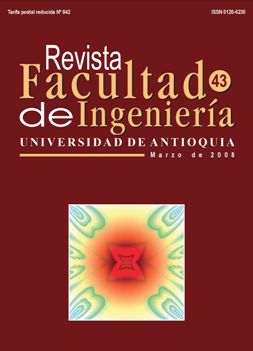Production and characterization of porous bodies of synthetic hydroxyapatite
DOI:
https://doi.org/10.17533/udea.redin.18628Keywords:
hydroxyapatite, porous body, foam, bioceramic, implantAbstract
The gel-casting process has been used for the preparation of ceramic and metallic materials making it possible to obtain shapes with controlled microstructure and mechanical properties. Hydroxyapatite (HA) is a bioactive ceramic, due to its capacity to form chemical bonds with the bone tissue but, it has low mechanical resistance. In this work HA foams were prepared using gel-casting, with two solid percentages, 40 and 50%. The obtained foams were characterized by X Ray Diffraction (XRD), Scanning Electronic Microscopy (SEM) and compression tests. Results show that the foams have open and interconnected pores with sizes close to 100 µm. Mechanical tests indicate that the compressive strength increases by increasing solid percentage. The high potential of this process is demonstrated for the fabrication of porous bodies to be used in reconstructive surgery.
Downloads
References
C. García, C. Paucar, J. Gaviria. “Estudio de algunos parámetros que determinan la síntesis de hidroxiapatita por la ruta de precipitación”. Revista Dyna. Vol. 148. 2006. pp. 9–15.
G. Ramírez, I. Escobar, A. Echavarría, J. Cardona, A. Giraldo, C. Riaño. “Características osteoconductoras de la HA sintética y la derivada de corales marinos injertados en conejos”. Revista Colombiana de Ciencias Pecuarias. Vol. 2. 1999. pp. 97–107.
A. Lax-Perez, L. Meseguer-Olmo, V. Vicente-Ortega, M. Alcara-Baños, M. Ros-Nicolas, M. Clavel-Nolla-San, P. Sepúlveda, C. Meseguer Ortiz. “Respuesta ósea al implante de espuma de hidroxiapatita (HA-02), Estudio experimental en conejos”. Revista Ortopedia y Traumatología. Vol. 49. 2005. pp. 293-300. DOI: https://doi.org/10.1016/S0482-5985(05)74430-8
P. Sepúlveda, J. G. P. Binner, S. O. Rogero, O. Z. Higa, J. C. Bressiani. “Production of porous hydroxyapatite by the gel-casting of foams and cytotoxic evaluation”. Journal of Biomedical Materials Research. Vol. 50. 2000. pp. 27-34. DOI: https://doi.org/10.1002/(SICI)1097-4636(200004)50:1<27::AID-JBM5>3.0.CO;2-6
P. Sepúlveda, A. Bressiani, J. Bressiani, L. Meseguer, B. Konig Jr. “In vivo evaluation of hydroxyapatite foams”. Materials Research. Vol. 5. 2002. pp. 253-256. DOI: https://doi.org/10.1590/S1516-14392002000300006
H. Ramay, M. Zhang. “Preparation of porous hydroxyapatite scaffolds by combination of gel-casting and polymer sponge methods”. Biomaterials. Vol. 24. 2003. pp. 3293-3302. DOI: https://doi.org/10.1016/S0142-9612(03)00171-6
M. Sinha, D. Basu, B. Sen. “Porous hidroxyapatite ceramic and its clinical applications” Interceramic Vol. 49. 2000. pp. 102-105
A. Lax, V. Ortega, L. Meseguer, M. Alcaraz, P. Sepúlveda, M. Clavel. ”Implante óseo de la espuma de hidroxiapatita-09 Estudio experimental en conejos” Revista Española de Patología. Vol. 38. 2005. pp. 14-20.
S. Dhara, R. Kamboj, M. Pradhan, P. Bhargava. “Shape forming of ceramics via gel-casting of aqueous particulate slurries”. Bull Materials Science. Vol. 25. 2002. pp. 565-568. DOI: https://doi.org/10.1007/BF02710552
Downloads
Published
How to Cite
Issue
Section
License
Revista Facultad de Ingeniería, Universidad de Antioquia is licensed under the Creative Commons Attribution BY-NC-SA 4.0 license. https://creativecommons.org/licenses/by-nc-sa/4.0/deed.en
You are free to:
Share — copy and redistribute the material in any medium or format
Adapt — remix, transform, and build upon the material
Under the following terms:
Attribution — You must give appropriate credit, provide a link to the license, and indicate if changes were made. You may do so in any reasonable manner, but not in any way that suggests the licensor endorses you or your use.
NonCommercial — You may not use the material for commercial purposes.
ShareAlike — If you remix, transform, or build upon the material, you must distribute your contributions under the same license as the original.
The material published in the journal can be distributed, copied and exhibited by third parties if the respective credits are given to the journal. No commercial benefit can be obtained and derivative works must be under the same license terms as the original work.










 Twitter
Twitter